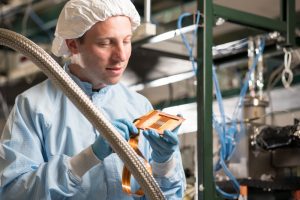
Javier Tiffenberg is developing sensitive CCDs for detecting lightweight dark matter particles. Photo: Reidar Hahn
Photographers know that the heart of digital camera technology is the CCD, or charge-coupled device. These small chips are divided into sections called pixels, which record information when light strikes them. A little bit of processing magic, and voilà, an image is born.
With some modifications, these silicon sensors are also incredibly useful for physics experiments. CCDs have been used for years to gather astronomical data for projects like the Dark Energy Survey. Last month, Fermilab’s Javier Tiffenberg was awarded the Department of Energy’s Early Career Research Award to investigate how to build large-scale detectors using special kinds of CCDs that can probe two of the most mysterious substances in the universe: neutrinos and dark matter.
The new type of sensors has potentially wide-ranging applications: The same qualities that make these CCDs useful for hunting dark matter and neutrinos also make it useful for astronomy, quantum information science and biomedicine.
Neutrinos are elusive particles that could hold the key to why matter and not antimatter predominates in the universe. But even 60 years after their discovery, scientists still don’t know much about them or why they behave the way that they do. Dark matter is similarly mysterious; while scientists infer dark matter exists from the way galaxies spin, they have never directly observed the strange material that is invisible (or dark) to telescopes and other instruments. Neutrinos are known to be very lightweight particles, and many theories—although not all — predict dark matter particles are low-mass as well.
The special kind of CCDs that Tiffenberg is advancing, called skipper CCDs, are well-suited to studying such lightweight particles with low energies. When operated at cryogenic temperatures (several hundred degrees Fahrenheit below zero), the sensitive pixels can record the incredibly small amount of energy deposited by neutrinos and, theoretically, dark matter particles.
While more energetic particles normally leave tracks that bloom across hundreds or thousands of pixels, low-energy particles are so light that they will deposit energy in just one. In order to make this data useful, scientists must know whether a signal in a single pixel is due to neutrinos or dark matter or whether they are seeing background noise that comes from the detector. The pixels in the skipper CCDs can be sampled multiple times without the data being destroyed, as it is in other CCDs. These multiple readings reduce the error rate and tell scientists when they’ve seen their quarry.
The observation of dark matter would be a ground-breaking discovery — and the skipper CCD technology was conceived with dark matter in mind. Originally proposed around 30 years ago, the technology didn’t quite work when it was first being developed. Tiffenberg and a few others, including collaborators at the Lawrence Berkeley MicroSystems Laboratory, decided to try the silicon-based technology again a few years ago and got it to function in 2016.
“It worked really well – much better than I expected,” he said. “We needed a technological breakthrough, and what we have now is a detector that essentially gets to the theoretical limits of silicon.”
For neutrino research, the skipper CCD could be particularly useful in experiments that investigate how neutrinos change as they travel over short distances. Low-energy neutrinos are a common output from nuclear reactors. A small detector that can consistently register those particles could help monitor nuclear reactors and play a role in nuclear nonproliferation.
A detector that demonstrates this technology will be one product of Tiffenberg’s $2.5 million DOE award, which will be spread over five years. The funds will also be used to hire a postdoctoral researcher, fabricate more sensors and a cryostat, and ultimately build a small-scale set-up. The end goal is to fully develop the technology, which entails a thorough understanding of silicon and how it reacts at low energy levels.
It also means conducting research and development to scale up the skipper CCDs: The technology has been demonstrated for detectors at the gram scale, and a 10-gram detector (separate from Tiffenberg’s award) should be operational by the end of this year. Scientists would like to see the technology advance to multiple kilograms, a significant challenge with incredible science potential.
“We are excited about the prospects for this CCD technology,” said Josh Frieman, head of Fermilab’s Particle Physics Division. “Javier’s Early Career Award will help pave the way to new discoveries with it.”



